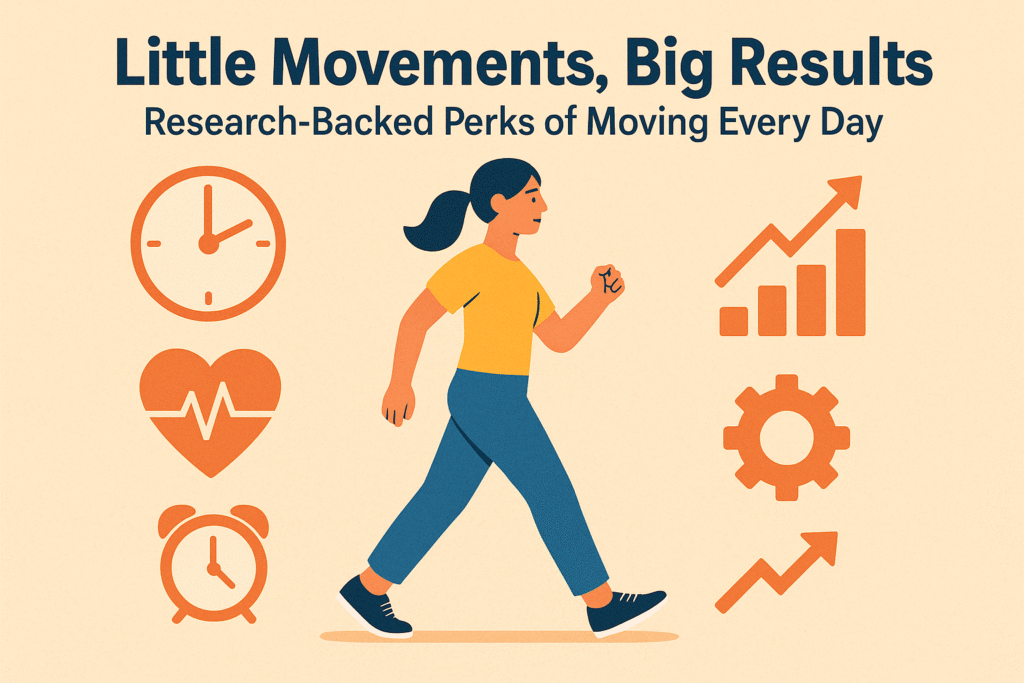
Little Movements, Big Results: Research-Backed Perks of Moving Every Day
Introduction: Redefining What Exercise Looks Like
Many people associate “exercise” with interminable sweat sessions in the gym, long runs, or strenuous workout routines. But scientific evidence has proved that even small amounts of regular movement, incorporated over a wide range of activities throughout the day, can yield huge health benefits — because you only have to do it a few times each day over time to see real results.
- Why Small Daily Movements Work Wonders

Studies show that breaking activity down into small intervals (like 2–5 minutes at a time) can improve cardiovascular health, stabilize blood sugar, and improve overall fitness. As opposed to forcing yourself into an all-day workout weekly, working out at least 5–6 times per day seems to result in a larger long-term improvement in health.

Eleven minutes of moderate-intensity activity a day (fast walking, cycling, or climbing stairs) can reduce the risk of heart disease, cancer, and premature death by more than 20%, research in more than 40,000 adults suggests.

While 10,000 steps is a popular target, experts at Harvard say 6,000–7,000 fast steps a day are enough to reduce mortality by up to 50%, particularly among adults over 40 years.
- Health Benefits That Add Up Over Time
- Health Benefits That Add Up Over Time
|
Benefit |
Types of “Small Moves” That Help |
Long-Term Impact |
|
Heart health |
Climbing stairs, power walking |
Better circulation, reduced blood pressure |
|
Weight control |
Movement breaks during sitting |
Higher daily calorie burn |
|
Blood sugar balance |
Short walk after meals |
Improved insulin sensitivity |
|
Mental clarity |
1-min intense bursts (e.g., jumping jacks) |
Increases focus, reduces anxiety and depression |
|
Longevity |
Daily light activity |
Lower risk of chronic diseases & early death |
- Easy Ways to Sneak Exercise Into Your Day
- Walk while talking on the phone
- Use stairs instead of elevators
- Replace scrolling breaks with 2-minute movement “snacks”
- Do “mini-workouts” — 15 push-ups + 15 jumping jacks, twice a day
These motions don’t feel like workouts, but they keep your body metabolically active — and that’s one of the keys to long-term health.
- The Science Behind These Big Benefits
Recent clinical research explains why even small doses of activity are so effective:
- A study from the University of Sydney found that performing just 1–2 minutes of vigorous bursts three times a day (during household chores, brisk walking, etc.) lowered heart-related deaths by 49%.
- According to The American Journal of Epidemiology, burning just 500–1,000 extra calories per week through daily movement reduces the risk of developing type-2 diabetes by about 6%.
- Regular movement increases production of BDNF, IGF-1, and VEGF — brain-protective chemicals that improve memory, focus, and mental resilience (Harvard Medical School).
- The Journal of the American Medical Association concluded that achieving 75–150 minutes of moderate activity per week, even in short fragments, decreases overall mortality by 35–42%.
Conclusion: Little Efforts, Long-Lasting Results
It does not mean to be in the gym for six hours a day, it means just to move more throughout the day with small movements, simple actions like walking more, climbing stairs, or doing short bursts of movement can create powerful changes when done consistently
